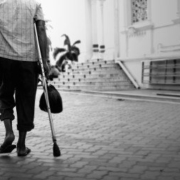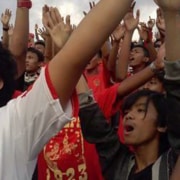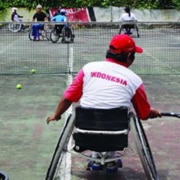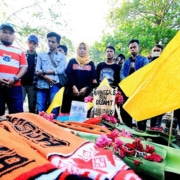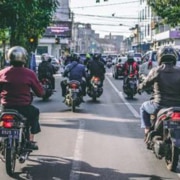
Asian Para Games athlete Maria Goreti Samiati. Photo by Mohammad Ayudha for Antara.
Indonesia has received widespread praise for the successful organisation of the 2018 Asian Games and Asian Para Games. While Indonesia deserved the plaudits it received, the Games also served to highlight outdated attitudes to people with disability.
Life for people with disability in Indonesia is highly challenging. They face poor accessibility to public facilities, transportation, and buildings, weak social security support, and patronising public attitudes. One of the most common public perspectives is to view people with disabilities as somehow extraordinary or deserving of compliments.
This way of viewing people with disabilities as “supercrips” is pervasive in Indonesia. It is consistent with a view of disability that sees people with disability as “others”, different from the majority. According to this view, any artistic, academic or sporting products or achievements produced by people with disability are considered extraordinary and worthy of effusive praise.
This type of attitude can also result in people with disability being praised for just going about their daily lives. It is not uncommon to hear comments like: “Even though she is deaf, she can still take great photographs”, or “He uses a wheelchair but he got the top marks in the maths exam”.
During the 2018 Asian Para Games, for example, a stranger approached me and shook my hand, exclaiming, “You are awesome, I am amazed”. He had never met me before. All I had been doing was walking through the grounds of the event.
Academic Jan Grue notes that the result of this view is that “the greater the achievement and the greater the impairment, the more impressive the supercrip.” Even if an artistic product has not been appraised or displayed alongside other artworks in a curated environment, as long as it is produced by a person with disability, it is considered to be an incredible or valuable work. Grue summarises this notion with the formula: (S)upercriphood = (A)chievement x (I)mpairment.
This notion of the “supercrip” interacts closely with perspectives that view people with disability as objects of charity. A charity perspective might see the government, with good intentions, providing opportunities for people with disability to participate in creating art. But often the end results are lauded without objective or professional judgment. Unlike other artworks, which are curated based on philosophical, technical or theoretical considerations, artworks of people with disability are often curated based on being produced by people with disability. Disability becomes the prominent focus, rather than the artwork.
This view is dominant in Indonesian society. I have visited many areas of Indonesia where people with disability are creating art but their works are simultaneously considered the result of “leisure activities”, rather than serious artistic endeavour, while also being considered worthy of high praise. Many government ceremonies are accompanied by dances, readings, or music performed by people with disability, which are then given excessive or exaggerated applause. They are judged according to their disabilities rather than the quality of their work. They are assumed to be incapable because of their disability, so the simple act of creating art is deemed worthy of praise.
Because of this perspective, it is not surprising that many non-disabled people see people with disability as objects of inspiration. The involvement of people with disability in art is primarily intended to give pleasure to the non-disabled people, resulting in excessive admiration and pity. This is what is known as “inspiration porn”. Disability is presented for its ability to satisfy or provide pleasure to the non-disabled, not as something that is normal.
The same patterns are also observed in sport. While the 2018 Asian Para Games was a high profile opportunity to introduce and educate people about disability and diversity, in reality, people with disability were again treated as objects of pity or sources of inspiration for non-disabled people. National daily newspaper Kompas dedicated its front page to the Games, stating in bold font: “They Inspire Us”.

The front page of Kompas on 6 October 2018.
Similarly, in an official video, President Joko Widodo and Vice President Jusuf Kalla said that people with disability were an inspiration to Asian society. In fact, the tagline for the biggest sporting event in Asia was: “The Inspiring Spirit and Energy of Asia”, and the official Para Games social media accounts shared updates with the hashtag #parainspirasi.
Inspiration porn rests on an underlying assumption that people with disability are weak and not able to do what non-disabled people can do. When people with disability achieve sporting success, it’s surprising and impressive for non-disabled people. Viewing people with disability as an inspiration actually subordinates them and singles them out as “the other”.
The works and achievements of people with disabilities are not considered as objects or achievements in their own right but the result of the efforts of a person with disability. This puts the emphasis on the disability and results in excessive praise or people with disability being used to satisfy the inspirational needs of non-disabled people.
This is the great challenge for disability rights activists in Indonesia. It is time to do away with the idea of the supercrip. People with disability are not superhuman or sources of inspiration, they are just people and part of Indonesia’s diverse society. Everybody has their own different characteristics, whether they relate to religion, sexual orientation, race, language, or disability.
The views and opinions expressed in this post do not represent the views of the Australian or Indonesian governments.


